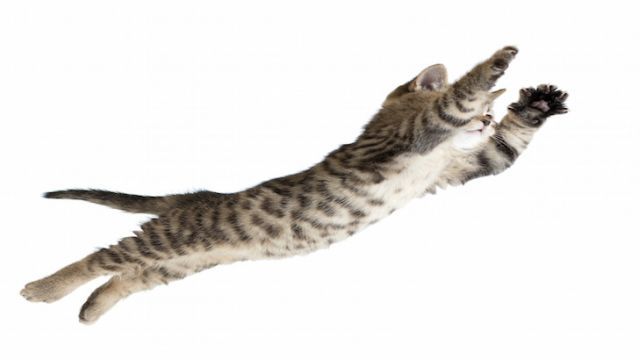
You probably don’t think Fluffy has much of a grasp of scientific principles — but you’re wrong. A recent Japanese study indicates felines use their sense of hearing to predict where prey may be located, although they can’t see the intended victim. Cats perceive a prey’s whereabouts through non-visual clues.
Of course, if you play with your cat, you already know he understands string theory…
Cause and effect
The Kyoko University study may win an award for the most adorable science project ever, as much of it consists of videotaped cat reactions. While the study proved that cats have an elemental understanding of physics and cause and effect, it also showed that cats score well in the common sense department. It’s not easy to fool a cat… unless you’re using a laser toy.
The experiment
Researchers showed 30 cats “either an object dropping out of an opaque container” or nothing dropping out when the containers were turned over. First, scientists shook the containers with objects to produce a rattling sound, but also shook the empty containers which didn’t produce noise. The felines then were allowed to roam around and explore the area where the experiment was conducted. Fifteen — or half — of the cats “actively explored” containers with an object that made noise in them. Just 10 cats explored the “no object and no sound” containers.
The results showed that cats looked at the container longer when there was noise than when there wasn’t — an action known as “preferential looking.” They also peered longer when an “incongruent” event occurred — such as an object dropping out of a container that didn’t make a noise, or no object dropping out of one that did rattle.
The researchers concluded the result “suggests that cats inferred the existence (or absence) of the object based on the rattling sound (or no sound) and predicted the appearance of the object (or not), applying a physical rule.” They surmised this reflects natural feline hunting ability, as they must often discover the location of prey solely by sound. Since cats are basically nocturnal — although as any cat lover knows, they sleep day and night — their primary hunting hours are spent in the dark. The study shows cats use cause and logic regarding noise to determine the presence of invisible objects.
Feline hearing
Dogs have a fantastic sense of smell, but felines possess exceptional hearing ability and beat the canines in the aural department. Although cats have good vision, hearing is their sharper sense. A typical feline’s audible range is 79 kilohertz, or about 10.5 octaves. Human hearing is in the 20 kilohertz range. That means a cat can distinguish the very high-pitched sounds made by rodents, inaudible to the human ear. He can tell the difference between similar ultrasonic sounds several yards away.
Feline ears have 22 muscles in the outer ear, or pinna. Consisting of cartilage and covered with hair, the pinna is designed to catch sound waves, sending them down the ear canal to the eardrum. You’ve certainly noticed that your cat can move his ears separately, and often communicates his emotional state via the ears.
Deafness
Does this mean a deaf or hard-of-hearing cat can’t hunt? Not necessarily, although he’s unlikely to perform this task well. In an area where prey is abundant, the deaf cat may still catch mice or other animals. It also depends on prey drive — there are some cats that really enjoy hunting and will pursue it enthusiastically even if they aren’t particularly successful. Of course, deaf cats really belong indoors, as the outside world is too dangerous for them.
Do try this at home
The Kyoto University experiment is one that you can try to replicate at home with your own kitties. The Kyoto University team used metal balls as items in the opaque containers. You can use anything that rattles, but consider expanding the experiment. Along with ordinary rattling items, switch to toy mice or similar objects resembling prey. See if your cats show more interest in prey-like pieces than other noisy articles.
In simple terms, cats understand an action leads to a reaction. Researchers still don’t know “what cats see in their mind’s eye when they pick up noises,” so further study is necessary.
—Jane Meggitt

